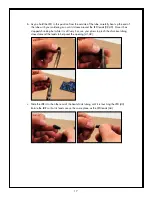
4
HOW IT WORKS
In general, Theremin circuits have two inputs: a pitch sensor, and a volume sensor. The pitch sensor
controls a circuit known as a voltage controlled oscillator (VCO), which generates the Theremin’s
audio signal. The volume sensor controls a circuit called a voltage controlled amplifier (VCA) which
alters the amplitude (or volume) of the audio signal that was generated by the VCO.
The Noisette circuit topology is basically the same as the original Theremin circuit. We are just
using a few modern components to obtain the same result. One of the main differences is instead of
vacuum tubes like in the original circuit, we are using integrated circuits (ICs, aka microchips) in the
VCO and VCA circuits.
The original Theremin circuit used capacitive sensitive antennas as its sensors. The Noisette uses light
detection sensors, known as LDRs (light dependent resistors) to determine the pitch and volume of
the audio. LDRs have a very large resistance across their pins in the dark, but the resistance drops
very low when light shines on them. For the pitch and volume sensors, we are using these LDRs in
a voltage divider circuit to obtain a variable voltage depending on how much light they detect. The
Noisette’s VCA also contains an LDR optocoupler. This optocoupler allows us to control the volume
of the audio through an LDR controlled by a light emitting diode (LED), the brightness of which is
controlled by the volume sensor circuit. The brighter the LED gets, the less resistance the LDR has,
causing the audio to get louder.
Figure 1 shows a block diagram of the Noisette circuit, to help visualize how it works.
VCA
VCO
PITCH
SENSOR
LDR
VOLUME
SENSOR
LDR
NOISETTE BLOCK DIAGRAM
LDR
LED
OPTO-
COUPLER
WAVE
SHAPE
MAX
VOLUME
HEADPHONE/LINE
OUT
SPEAKER
OUT
GAIN
SETTING
JUMPER
Figure 1: Noisette Block Diagram



















